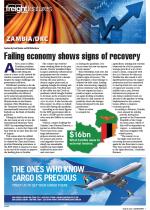Plans to connect Zambia’s rail network to the ports of Beira and Walvis Bay will not only benefit the mining industry, which will provide the volumes required to justify the investment.In April it was announced that a study commissioned by the Namibian ministry of works had found that connecting Namibia and Zambia by rail through a $2.26-billion project was both commercially and environmentally viable.The proposed route for the Trans-Zambezi Railway (TZR) extension will go from Grootfontein to Katima Mulilo via Rundu in Namibia and from there into the Zambezi region to the west of Zambia.It will serve mines in Zambia and the Democratic Republic of Congo (DRC), as well as the agricultural and manufacturing sectors. The Walvis Bay – Ndola – Lubumbashi Development Corridor “is perfectly positioned to service the two-way trade between the SADC region and Europe, North and South America, and emerging markets in the East,” according to a statement by Canadian mining company Tsodilo Resources. The study was conducted by M R Technofin Consultants (Canada) and co-funded by the Government of the Republic of Namibia and the African Development Bank.Partners in the study include Namibian companies Burmeister & Partners, Enviro Dynamics, and Koep & Partners. The University of Cape Town and TI Progetti of Italy also contributed.The study recommends that the “Cape Gauge” of 1 067mm be specified for the 772km greenfield line as this is the standard in the region.In 2007, the African Union recommended that all new projects should be built on the “standard gauge” of 1 435mm, but the study found that the transhipment costs where the two rail systems meet would make this uneconomical. A design axle load of 18.5 tons is recommended, allowing freight trains to travel at 80 kmph pulled by diesel locomotives.“The Namibian Railway as well as the railways in Angola, Botswana and Zambia have been running on diesel traction. “Maintaining diesel traction would maintain regional f luidity of train movements.“Furthermore, while the traffic potential for this study indicates that there is a commercial case for developing the line, it is not likely that traffic volumes would justify electrifying the line today,” the study states. The new route will tie into rail upgrades already under way in Namibia, including the 600km stretch from Walvis Bay to Grootfontein, which will require a new marshalling yard as the existing one is in the middle of the city.Therefore, an immediate next step is to also start conducting the full environmental and social impact assessment and to acquire the necessary approvals from the local environmental authority.

